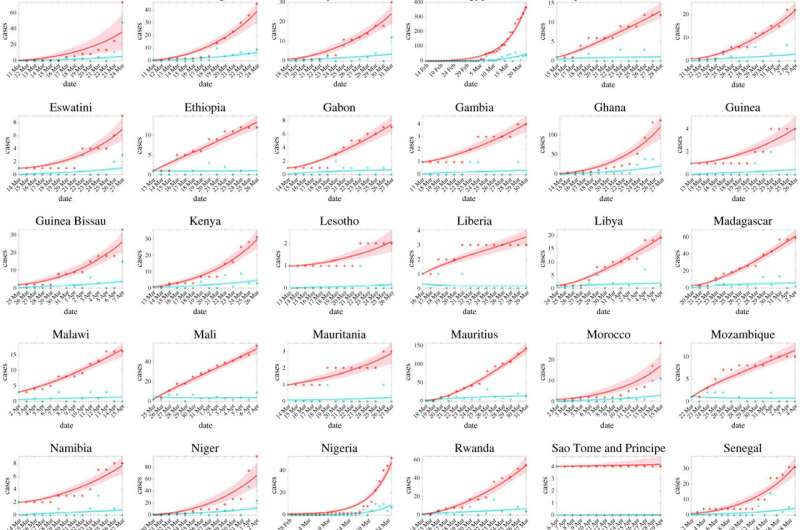This article has been reviewed according to Science X's editorial process and policies. Editors have highlighted the following attributes while ensuring the content's credibility:
fact-checked
peer-reviewed publication
trusted source
proofread
Study finds COVID cases underreported in most African countries during initial stage

A new analysis of COVID-19 cases in Africa shows that for most of the continent's countries the rate of infection was likely much higher than reported in the initial stages, found York University researchers.
Case counts reported by most African countries suggest the virus spread slowly during the early part of the pandemic, but the researchers say those numbers likely didn't capture the true extent of the spread.
"The low reporting numbers was likely due to a lack of public awareness, public health resources, monitoring practices, testing availability and stigma," says Faculty of Science Professor Jude Kong, senior author of the paper and director of the Global South Artificial Intelligence for Pandemic and Epidemic Preparedness and Response Network (AI4PEP).
To get a better handle on the real number of those infected, the researchers used an epidemiological mathematical model, along with observed data, for 54 countries in Africa to estimate the number of hidden infections. Data on cumulative number of cases and daily confirmed cases were used to build an epidemic profile for Africa of the initial stage of COVID-19.
What may be most surprising is the estimation that some 66 percent of all infections in Africa were asymptomatic, while about five percent were severe and about 27 percent were mild.
"Africa is primarily comprised of a young population so it's possible there were fewer cases, less severe symptoms or more people with asymptomatic symptoms than in a population that has a higher percentage of seniors," says Postdoctoral Fellow Qing Han, lead researcher on the paper. "This suggests the possibility of a lower rate of detection of the virus."
The researchers found that the basic reproduction number (R0) in each country was much higher than when only reported cases were used as the average overall case reporting rate was low—estimated at about five percent continent-wide—in the early stages for each country. They estimate that the real mean R0 is 2.02 compared to the reported R0 of 0.17 and ranged from 1.12 in Zambia and 3.64 in Nigeria.
"Counties that showed a R0 of less than one, which basically means there was no outbreak, likely have a much higher true R0. Not investigating the underreported figures could cause an underestimation of the severity and magnitude of the epidemic locally in each country," says Han.
Those countries with the highest number of severe infections also tended to have the highest reported cases and those with the lowest severe infections generally had the lowest report rate. The researchers say the predicted true numbers of cumulative cases are high above what was reported for all countries with Sudan and Gambia reporting collectively most at 27 percent and 22 percent, while most countries reported less than five percent.
Northern and southern African countries had higher reporting rates compared to central Africa, which could be explained in part by higher health-care spending in the north and south regions. Libya topped all the African countries for having the most nurses and physicians per 1,000 people.
"The estimated low reporting rates in most African countries point to a need for improved reporting and surveillance systems especially for central Africa," says Kong, co-executive director of the Africa-Canada Artificial Intelligence and Data Innovation Consortium.
The paper, "Estimation of epidemiological parameters and ascertainment rate from early transmission of COVID-19 across Africa," is published in Royal Society Open Science.
More information: Qing Han et al, Estimation of epidemiological parameters and ascertainment rate from early transmission of COVID-19 across Africa, Royal Society Open Science (2023). DOI: 10.1098/rsos.230316



















